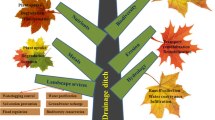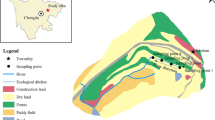Abstract
Plant species have an important role in eco-ditches; however, the Michaelis–Menten kinetic parameters of nutrient uptake, growth rate and purification efficiency of ditch plants and their influences on domestic sewage treatment efficiency are still unclear. Growth rates of all nine species, but especially Lemna gibba, Cladophora and Myriophyllum verticillatum were best in undiluted domestic sewage as opposed to a mixture of domestic sewage. Performance of species to accumulate nutrients was not only species-specific, but was also affected by both sewage treatments. Removal efficiency of nutrients was dependent on both plant species and treatment. Uptake kinetic parameters were significantly affected by both nutrient form and plant species. The maximum uptake rate (Vmax) of NH4-N was higher than NO3-N. Similarly, Km values for NH4-N were greater than NO3-N. These results could be used to identify plants for sewage treatment efficiency and enhance water quality in eco-ditch treatment systems.




Similar content being viewed by others
References
Anderson DM, Burkholder JM, Cochlan WP, Glibert PM, Gobler CJ, Heil CA, Kudela RM, Parsons ML, Rensel J, Townsend DW, Trainer VL, Vargo GA (2008) Harmful algal blooms and eutrophication: examining linkages from selected coastal regions of the United States. Harmful Algae 8:39–53
Barber SA (1995) Soil nutrient bioavailability: a mechanistic approach. 2nd edition. Wiley, New York
Bennett ER, Moore MT, Cooper CM, Smith S Jr, Shields FD Jr, Drouillard KG, Schulz R (2005) Vegetated agricultural drainage ditches for the mitigation of pyrethroid-associated runoff. Environ Toxicol Chem 24:2121–2127
Boesch DF (2002) Reversing nutrient over-enrichment of coastal waters: Challenges and opportunities for science. Estuaries 25:744–758
Chinese Environmental Protection Bureau (2002) Guide of analysis methods for water and wastewater, 3rd ed. Publishing House of Environmental Science, Beijing (in Chinese)
Daniels RE (1991) Variation in the performance of Phragmites australis in experimental culture. Aquat Bot 42:41–48
Elsaesser D, Stang C, Bakanov N, Schulz R (2013) The Landau stream mesocosm facility: pesticide mitigation in vegetated flow-through streams. Bull Environ Contam Toxicol 90:640–645
Gottschall N, Boutin C, Crolla A, Kinsley C, Champagne P (2007) The role of plants in the removal of nutrients at a constructed wetland treating agricultural (dairy) wastewater, Ontario, Canada. Ecol Eng 29:154–163
Iseyemi OO, Farris JL, Moore MT, Choi SE (2016) Nutrient mitigation efficiency in agricultural drainage ditches: an influence of landscape management. Bull Environ Contam Toxicol 96:750–756
Konnerup D, Brix H (2010) Nitrogen nutrition of Canna indica: Efects of ammonium versus nitrate on growth, biomass allocation, photosynthesis, nitrate reductase activity and N uptake rates. Aquat Bot 92:142–148
Kröger R, Holland MM, Moore MT (2008) Agricultural drainage ditches mitigate phosphorus loads as a function of hydrological variability. J Environ Qual 37:107–113
Kumwimba MN, Xibai Z, Lingyu B (2013) Uptake kinetics of arsenic by lettuce cultivars under hydroponics. Afr J Environ Sci Technol 5:321–328
Kumwimba MN, Xibai Z, Lingyu B, Jinjin W (2014) A preliminary study on genetic variation of arsenic concentration in 32 different genotypes of leafy vegetable. Environ Pollut 3:3 doi:10.5539/ep.v3n3p72
Kumwimba MN, Zhu B, Zhixin D, Tang, JL, Wang T, Liwei X, Muyembe DK (2016a) Assessing nutrient, biomass and sediment transport of drainage ditches in the Three Gorges Reservoir area. Clean Soil Air Water. doi:10.1002/clen.201501012
Kumwimba NM, Zhu B, Wang T, Yuan Z, Kavidia MD (2016b) Metal distribution and contamination assessment in drainage ditch water in the main rice/vegetable area of Sichuan hilly basin. Bull Environ Contam Toxicol 96:248–253
Kumwimba MN, Zhu B, Wang T, Muyembe DK (2016c) Distribution and risk assessment of metals and arsenic contamination in man-made ditch sediments with different land use types. Environ Sci Pollut Res. doi:10.1007/s11356-016-7690-1
Kumwimba NK, Zhu B, Suanon F, Dzakpasu M, Kavidia DM (2017) Long-term impact of primary domestic sewage on metal/loid accumulation in drainage ditch sediments, plants and water: implications for phytoremediation and restoration. Sci Total Environ 581:773–781
Lineweaver H, Burk D (1934) The determination of enzyme dissociation constants. J Am Chem Soc 56:658–666
Liu J, Vyverman W (2015) Differences in nutrient uptake capacity of the benthic filamentous algae Cladophora sp., Klebsormidium sp. and Pseudanabaena sp. under varying N/P conditions. Bioresour Technol 179:234–242
McJannet CL, Keddy PA, Pick FR (1995) Nitrogen and phosphorus tissue concentrations in 41 wetland plants: a comparison across habitats and functional groups. Funct Ecol 9:231–238
Moore MT, Bennett ER, Cooper CM, Smith S Jr, Farris JL, Drouillard KG, Schulz R (2006) Influence of vegetation in mitigation of methyl parathion runoff. Environ Pollut 142:288–294
Moore MT, Kröger R, Locke MA, Cullum RF, Steinriede RW Jr, Testa S III, Lizotte RE Jr, Bryant CT, Cooper CM (2010) Nutrient mitigation capacity in Mississippi Delta, USA drainage ditches. Environ Pollut 158:175–184
Princic A, Mahne I, Megusar F, Paul EA, Tiedje JM (1998) Effects of pH and oxygen and ammonium concentrations on the community structure of nitrifying bacteria from wastewater. Appl Environ Microbiol 64:3584–3590
Schindler DW (2006) Recent advances in the understanding and management of eutrophication. Limnol Oceanogr 51:356–363
Shi RH (1994) Determination of the total nitrogen in plant materials. In: Shi RH, Bao SD, Qin HY, An ZS (eds) Soil agriculture chemistry analysis method. China Agriculture Press, Beijing, pp 213–216 (in Chinese)
Tanner CC, D’Eugenio J, McBride GB, Sukias JPS, Thompson K (1999) Effect of water level fluctuation on nitrogen removal from constructed wetland mesocosms. Ecol Eng 12:67–92
USEPA (2012) Preventing eutrophication: scientific support for dual nutrient criteria. EPA-820-S-12-002. Office of Water, Washington, DC
Wang L, Gan H, Wang F, Sun X, Zhu Q (2010) Characteristic analysis of plants for the removal of nutrients from a constructed wetland using reclaimed water. Clean Soil Air Water 38: 35–43
Zhang ZH, Rengel Z, Meney K (2009) Kinetics of ammonium, nitrate and phosphorus uptake by Canna indica and Schoenoplectus validus. Aquat Bot 91:71–74
Zhou XH, Wang GX, Yang F (2011) Characteristics of growth, nutrient uptake, purification effect of Ipomoea aquatica, Lolium multiflorum, and Sorghum sudanense grown under different nitrogen levels. Desalination 273:366–374
Acknowledgements
The authors are grateful to the Natural Science Foundation of China (41371462), the CAS Western Light Talent Culture Project, and the Chinese Academy of Sciences-The World Academy of Sciences (CAS-TWAS) president’s fellowship program for developing countries for financial support of this work.
Author information
Authors and Affiliations
Corresponding author
Additional information
Mathieu Nsenga Kumwimba and Bo Zhu have contributed equally to this work.
Rights and permissions
About this article
Cite this article
Kumwimba, M.N., Zhu, B. Effectiveness of Vegetated Drainage Ditches for Domestic Sewage Effluent Mitigation. Bull Environ Contam Toxicol 98, 682–689 (2017). https://doi.org/10.1007/s00128-017-2054-1
Received:
Accepted:
Published:
Issue Date:
DOI: https://doi.org/10.1007/s00128-017-2054-1




